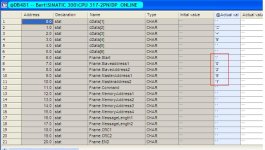Hello all,
my task is to send an array of ASCII codes through VIPA CP341.
The device which I want to connect uses its own framing like this:


The current problem is that I need to take a byte variable (b#16#02 for example) and transfer it to ASCII code like "30 32" (that means divide byte for two chars) but SCL don't have anything like BYTE_TO_STRING (similar to INT_TO_STRING) for that purpose. =(
Do I need to write my own block with comparison table or there some other way to form a string from a different parts?
Also the reverse operation is needed for reply encoding.
Will be grateful for any help!

my task is to send an array of ASCII codes through VIPA CP341.
The device which I want to connect uses its own framing like this:
The current problem is that I need to take a byte variable (b#16#02 for example) and transfer it to ASCII code like "30 32" (that means divide byte for two chars) but SCL don't have anything like BYTE_TO_STRING (similar to INT_TO_STRING) for that purpose. =(
Do I need to write my own block with comparison table or there some other way to form a string from a different parts?
Also the reverse operation is needed for reply encoding.
Will be grateful for any help!






